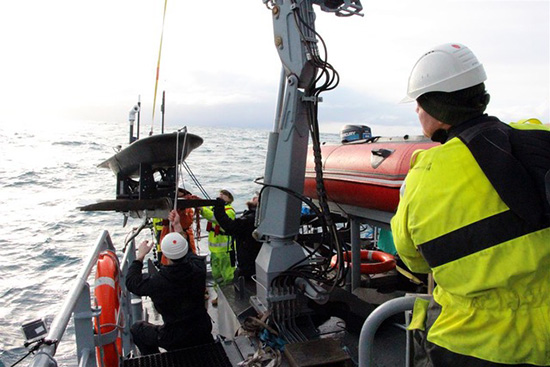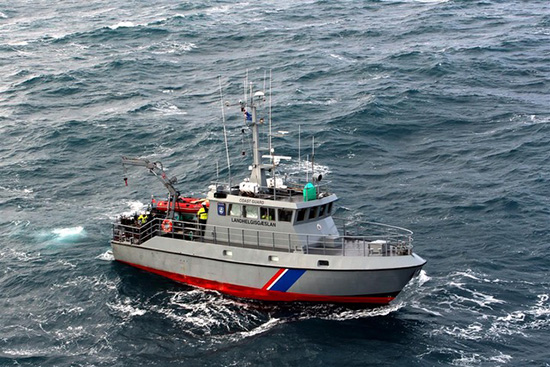Scripps Scientists, Icelandic Coast Guard Collaborate on Wave Study
Region of rough seas deemed ideal location for research
By:
- Robert Monroe
Media Contact:
- Robert Monroe - scrippsnews@ucsd.edu
- Mario Aguilera - maguilera@ucsd.edu
Published Date
By:
- Robert Monroe
Share This:
Article Content

The crew of Icelandic Coast Guard survey vessel Baldur deploys a Wave Glider Feb. 22, 2017 off the country's coastline. Wave Gliders measure surface winds and other conditions and add to a suite of measurements in a strongly stormy region to study the formation of large ocean waves. Researchers report that instruments have already recorded open ocean waves in excess of 12 meters (40 feet). The collaboration between Scripps Institution of Oceanography at the University of California San Diego and the Icelandic Coast Guard is expected to last at least two more years.
Scripps Institution of Oceanography at the University of California San Diego is collaborating with the Icelandic Coast Guard (ICG) on a groundbreaking study of the extreme ocean surface conditions that characterize the waters off that country’s coast.
Scripps physical oceanographer Eric Terrill said he and other Scripps scientists first approached Icelandic officials with the concept of deploying a suite of marine instruments because of the unique ocean conditions that are found there.
“Measuring the waves that form from high winds can be a challenge due to the difficulty of being at the right place and right time,” said Terrill. “In analyzing the statistics of the global wave climate, it became clear that Icelandic waters are an ideal natural laboratory for studying extreme conditions as conditions in excess of sea state 7 are the norm during the winter.”
The sea state 7 category corresponds to regular wave heights between six and nine meters (20 to 30 feet).
Rough seas are common around Iceland as a result of shifting winds moving across the high latitudes, and the waves encountering variable currents.

Icelandic Coast Guard survey vessel Baldur, from which crew members deployed two Wave Gliders and a wave buoy Feb. 22, 2017 off the country's coastline. Wave Gliders measure surface winds and other conditions and add to a suite of measurements in a strongly stormy region to study the formation of large ocean waves. Researchers report that instruments have already recorded open ocean waves in excess of 12 meters (40 feet). The collaboration between Scripps Institution of Oceanography at the University of California San Diego and the Icelandic Coast Guard is expected to last at least two more years.
The collaboration between the Scripps scientists and the Icelandic Coast Guard was formalized on Feb. 13 by the signing of a memorandum of understanding by senior leaders from both organizations as well as the Marine Freshwater Research Institute and the University of Iceland. The scientists, sponsored by the Office of Naval Research, are expected to continue their ocean observations of waves, winds, pressure, temperature and currents for at least two more years, and will be broadening their interaction with the greater Icelandic scientific community in the coming months. It is one of several ventures Scripps researchers undertake with national governments to improve observations of nature and protect marine environments.
Terrill recently aided the government of Palau in creating a plan to protect marine life, employing technology to enhance monitoring of that Pacific island country’s territorial waters.
Luca Centurioni, another Scripps oceanographer and director of a buoy network called the Global Drifter Program, said understanding and forecasting surface ocean currents and weather around Iceland requires frequent direct observations from drifting buoys that collect and report data in real-time via satellite to support numerical weather prediction and to calibrate satellites.
The scientists will bring new state-of-the-art instruments to measure waves, currents, atmospheric pressure, and sea surface temperature. Already, an expendable buoy developed by Terrill’s technical team has reported seas in excess of 12 meters (40 feet) in its first week of operation in the chilly Icelandic waters.
Among the other instruments are expendable drifters that will be deployed by the Icelandic Coast Guard during normal patrols and training. In addition, two commercially available Liquid Robotics Wave Gliders® that harness the energy of surface waves to provide propulsion will be operated during the pilot phase of the study. These will make long-duration mobile measurement platform of the winds and ocean response to the weather.
The measurement network of buoys and gliders will improve the scientific understanding of the coupling across the air-sea interface, a critical component for ocean, atmosphere and climate research. The study also provides ocean condition situational awareness to the ICG for their maritime mission to serve and protect commercial marine traffic, and will improve the ocean forecast models they rely upon for patrol planning. Direct measurements of ocean currents can also greatly improve the effectiveness of search and rescue missions.
“The Icelandic Coast Guard is very pleased with the cooperation with Scripps Institution of Oceanography,” said Ásgrímur L. Ásgrímsson, chief of operations of the Icelandic Coast Guard. “The data collected by the two Wave Gliders and the buoys will be of great value for relevant Icelandic institutions for future weather, wave, and current predictions and thus contribute to safer maritime traffic. The Icelandic Coast Guard remains committed to its support for maritime science in the North Atlantic, which is among the roles entrusted to the organization by Icelandic law.”
Share This:
Stay in the Know
Keep up with all the latest from UC San Diego. Subscribe to the newsletter today.



